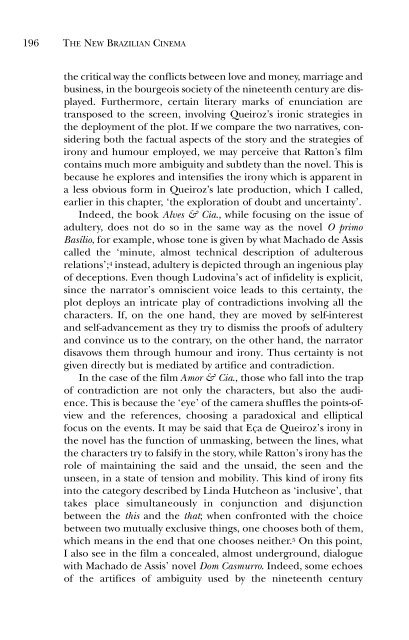Sertão
Sertão
Sertão
Create successful ePaper yourself
Turn your PDF publications into a flip-book with our unique Google optimized e-Paper software.
196<br />
THE NEW BRAZILIAN CINEMA<br />
the critical way the conflicts between love and money, marriage and<br />
business, in the bourgeois society of the nineteenth century are displayed.<br />
Furthermore, certain literary marks of enunciation are<br />
transposed to the screen, involving Queiroz’s ironic strategies in<br />
the deployment of the plot. If we compare the two narratives, considering<br />
both the factual aspects of the story and the strategies of<br />
irony and humour employed, we may perceive that Ratton’s film<br />
contains much more ambiguity and subtlety than the novel. This is<br />
because he explores and intensifies the irony which is apparent in<br />
a less obvious form in Queiroz’s late production, which I called,<br />
earlier in this chapter, ‘the exploration of doubt and uncertainty’.<br />
Indeed, the book Alves & Cia., while focusing on the issue of<br />
adultery, does not do so in the same way as the novel O primo<br />
Basílio, for example, whose tone is given by what Machado de Assis<br />
called the ‘minute, almost technical description of adulterous<br />
relations’; 4 instead, adultery is depicted through an ingenious play<br />
of deceptions. Even though Ludovina’s act of infidelity is explicit,<br />
since the narrator’s omniscient voice leads to this certainty, the<br />
plot deploys an intricate play of contradictions involving all the<br />
characters. If, on the one hand, they are moved by self-interest<br />
and self-advancement as they try to dismiss the proofs of adultery<br />
and convince us to the contrary, on the other hand, the narrator<br />
disavows them through humour and irony. Thus certainty is not<br />
given directly but is mediated by artifice and contradiction.<br />
In the case of the film Amor & Cia., those who fall into the trap<br />
of contradiction are not only the characters, but also the audience.<br />
This is because the ‘eye’ of the camera shuffles the points-ofview<br />
and the references, choosing a paradoxical and elliptical<br />
focus on the events. It may be said that Eça de Queiroz’s irony in<br />
the novel has the function of unmasking, between the lines, what<br />
the characters try to falsify in the story, while Ratton’s irony has the<br />
role of maintaining the said and the unsaid, the seen and the<br />
unseen, in a state of tension and mobility. This kind of irony fits<br />
into the category described by Linda Hutcheon as ‘inclusive’, that<br />
takes place simultaneously in conjunction and disjunction<br />
between the this and the that; when confronted with the choice<br />
between two mutually exclusive things, one chooses both of them,<br />
which means in the end that one chooses neither. 5 On this point,<br />
I also see in the film a concealed, almost underground, dialogue<br />
with Machado de Assis’ novel Dom Casmurro. Indeed, some echoes<br />
of the artifices of ambiguity used by the nineteenth century
















